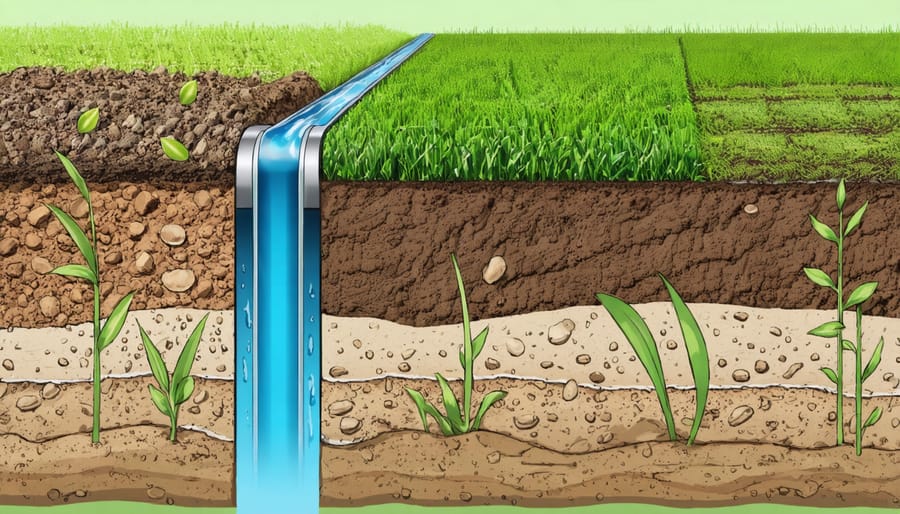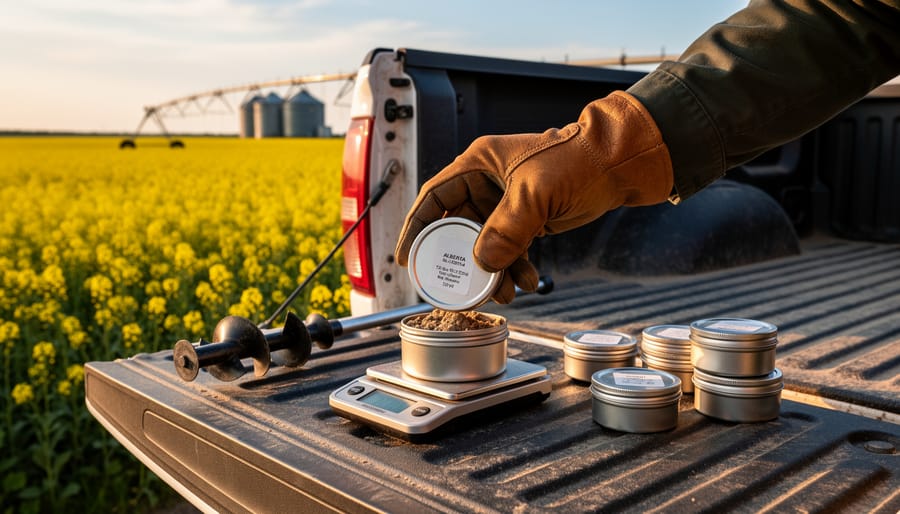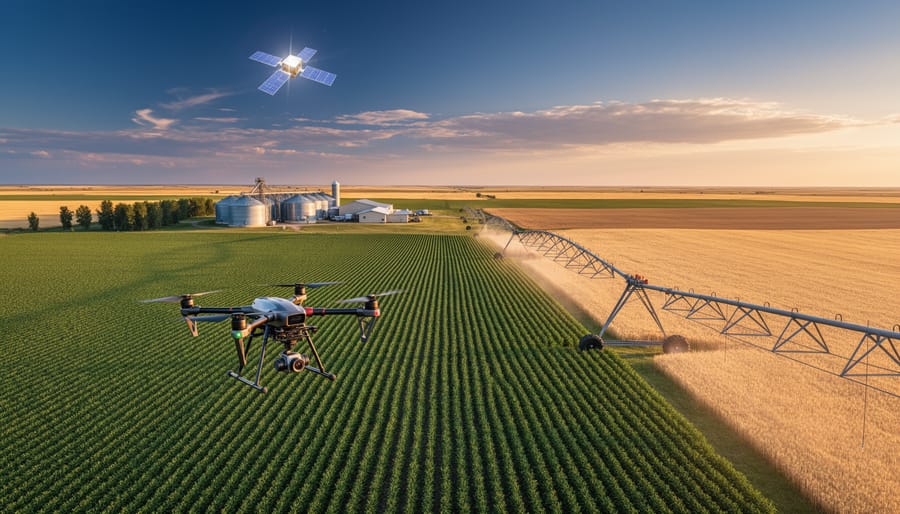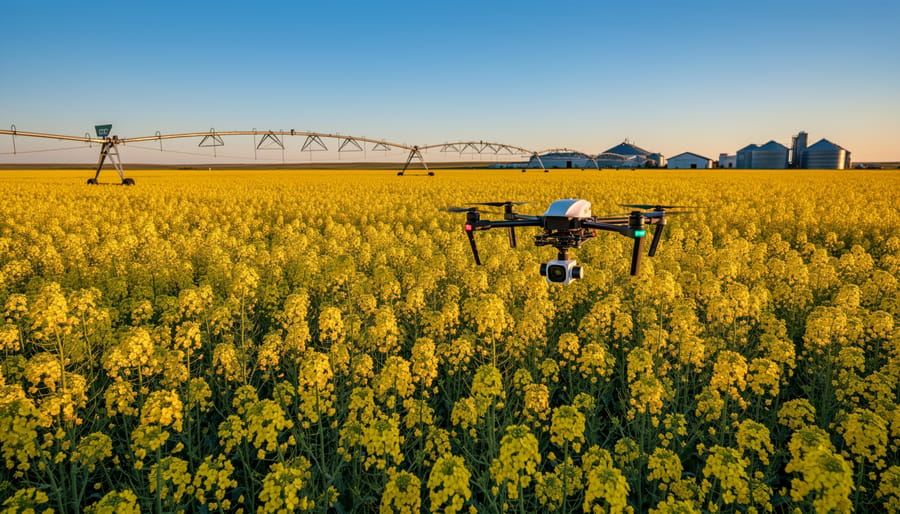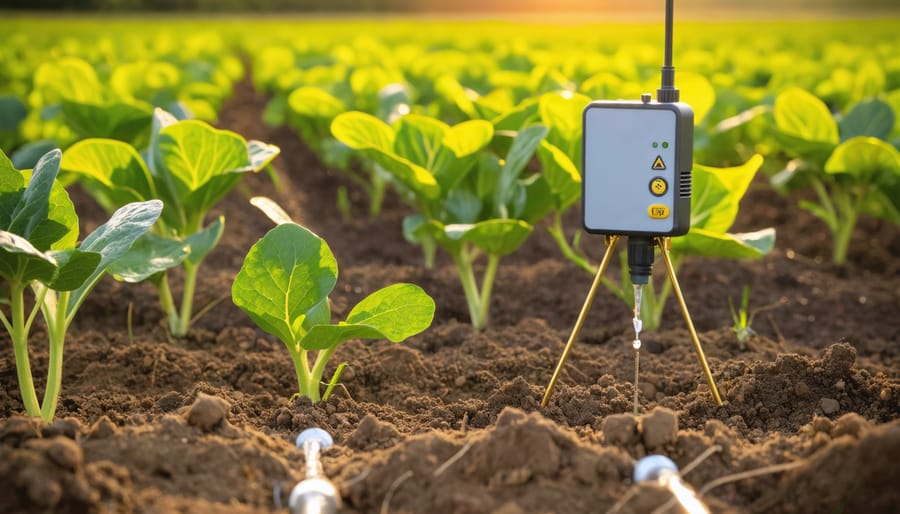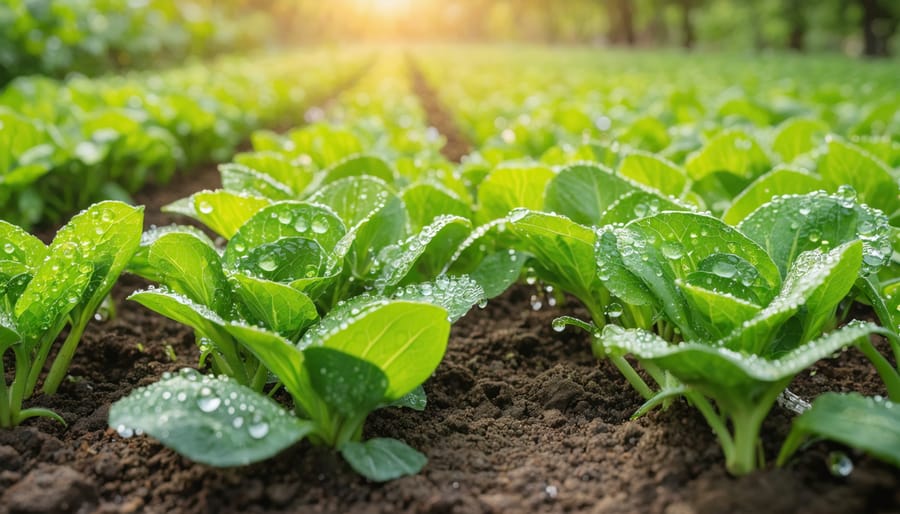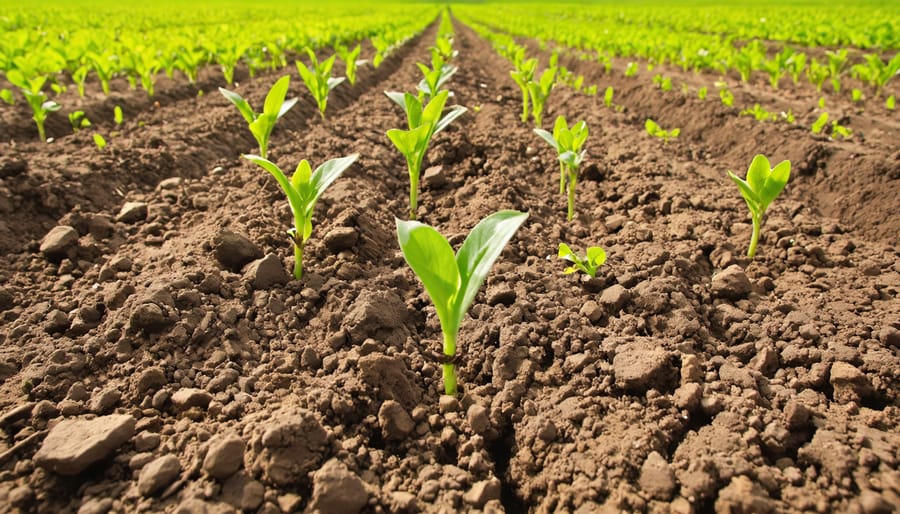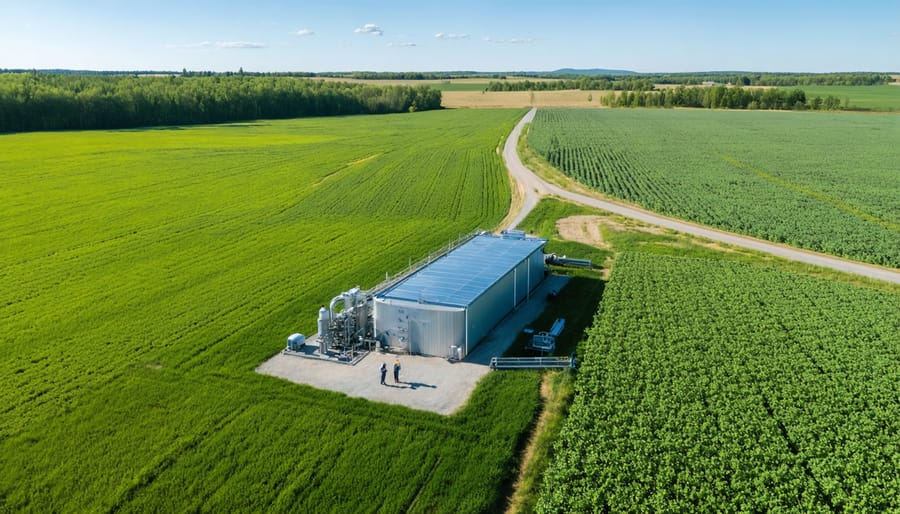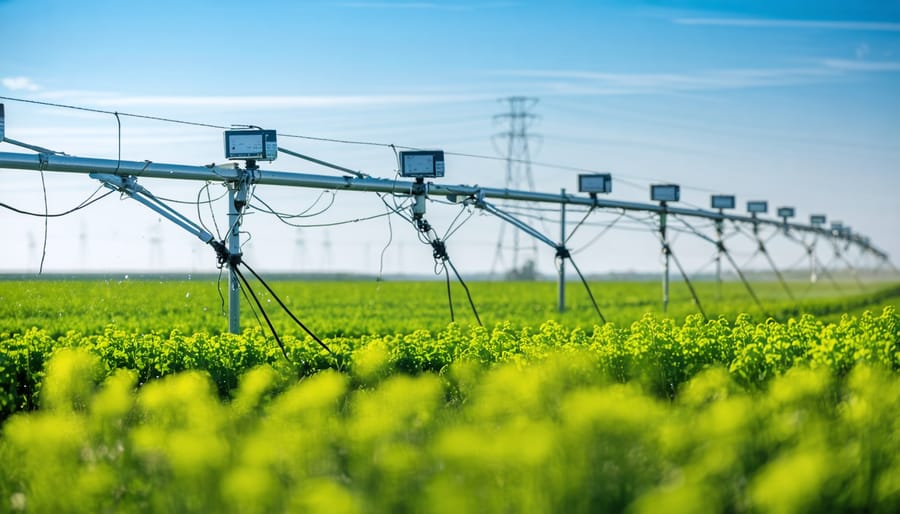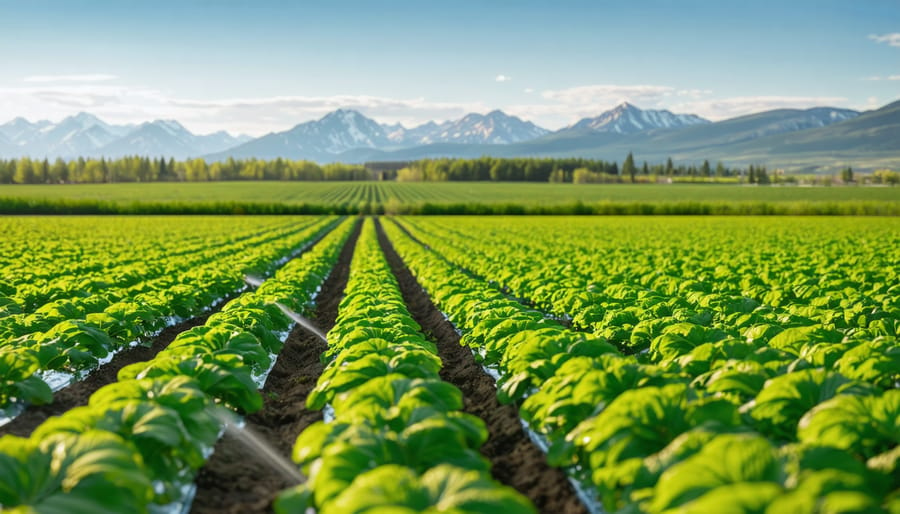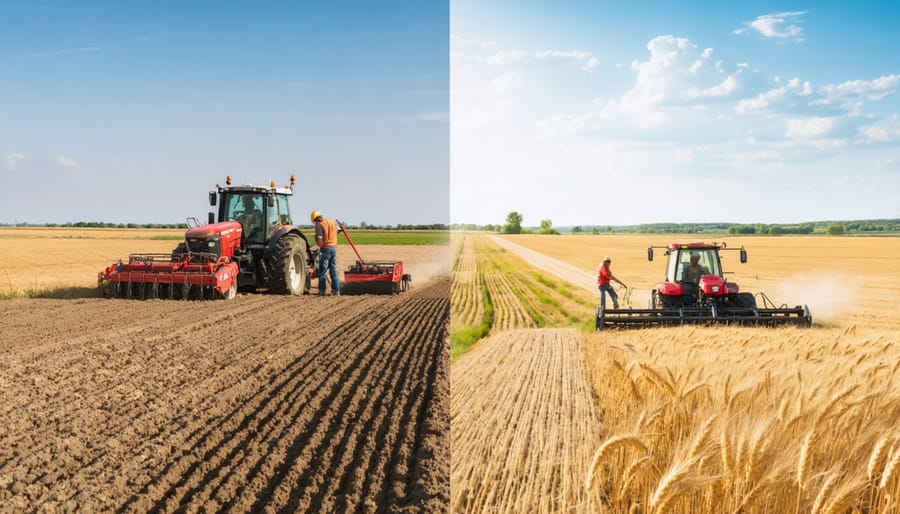Transform your farm’s water management by implementing a strategic water infiltration basics system that maximizes soil moisture and reduces runoff. Alberta farmers have documented up to 40% improvement in water retention through properly designed infiltration networks, combining perforated pipes, strategically placed catch basins, and permeable surface materials. These systems prove particularly valuable during our intense summer storms, capturing and directing water where crops need it most while preventing soil erosion and nutrient loss.
Recent field studies across Prairie provinces demonstrate that integrated water infiltration systems pay for themselves within 2-3 growing seasons through reduced irrigation costs and improved crop yields. By working with natural landscape contours and soil composition, these systems enhance groundwater recharge while maintaining optimal moisture levels for root development. For Alberta farmers facing increasingly unpredictable precipitation patterns, a well-designed infiltration system serves as both a drought-mitigation strategy and a flood-prevention tool.
How Water Infiltration Systems Transform Your Soil
The Science Behind Soil Water Movement
Water movement through soil follows predictable patterns based on soil structure and composition. In Alberta’s diverse soil types, from the rich black soil zones to brown chernozemic soils, water typically moves both vertically and horizontally through three main forces: gravity, capillary action, and osmotic pressure.
When water first hits the soil surface, gravity pulls it downward through large pore spaces between soil particles. This initial movement, called gravitational flow, is fastest in well-structured soils with good aggregation. As water continues to move, capillary action takes over, drawing water sideways and upward through smaller pore spaces – much like a paper towel absorbing water.
The soil’s texture plays a crucial role in this process. Sandy soils allow rapid infiltration but poor retention, while clay soils slow infiltration but hold water longer. The ideal soil structure for most Alberta crops contains a balance of particle sizes and stable aggregates, creating channels for water movement while maintaining adequate moisture for plant roots.
Understanding these movement patterns helps farmers make informed decisions about irrigation timing and drainage system design, ultimately improving water use efficiency on their farms.
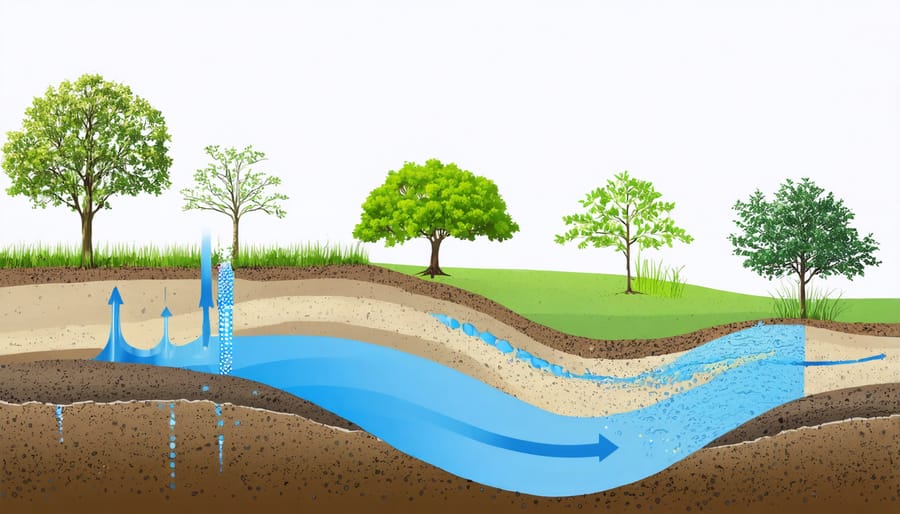
Your Soil’s Water-Holding Capacity
Your soil’s ability to hold water is crucial for successful farming in Alberta’s diverse climate conditions. Several key factors determine how effectively your soil retains moisture, including its texture, organic matter content, and structure. Sandy soils typically drain quickly, while clay-rich soils tend to hold water longer but may become waterlogged.
The good news is that you can improve your soil’s water-holding capacity through various soil moisture retention techniques. Adding organic matter, such as crop residue or composted manure, helps create a soil structure that balances water retention and drainage. For every 1% increase in organic matter, soil can hold approximately 25,000 more litres of water per hectare.
Consider your soil’s composition when planning your water infiltration system. Local farmers have found success by maintaining ground cover and implementing reduced tillage practices. These methods help protect soil structure and create natural pathways for water movement. Regular soil testing can help you monitor improvements in your soil’s water-holding capacity and adjust your management practices accordingly.
Practical Infiltration Techniques for Alberta Farms
Surface Infiltration Methods
Surface infiltration methods are practical techniques that help maximize water absorption into your soil while preventing erosion. Here in Alberta, many farmers have found success with contour farming, a method where you plant and till along the natural contours of your land rather than in straight lines. This approach slows water flow across slopes, giving it more time to soak into the soil.
Infiltration trenches are another effective solution, particularly popular among farmers in central Alberta’s rolling landscapes. These shallow channels, typically 30-60 cm deep and lined with gravel, capture runoff and allow it to gradually seep into the surrounding soil. Local farmer Mike Thompson from Red Deer County reports a 40% improvement in soil moisture retention since implementing these trenches on his wheat fields.
Level spreaders and berms work hand-in-hand with these methods, helping distribute water evenly across your fields. Consider installing grass waterways in natural drainage areas to further slow water movement and prevent soil loss. Many Alberta farmers combine these techniques with cover crops to enhance their effectiveness.
For best results, assess your land’s slope and soil type before choosing a method. The Agricultural Fieldman in your county can provide specific recommendations based on local conditions and success stories from neighbouring farms. Remember, these systems work best when maintained regularly and adjusted seasonally according to rainfall patterns.
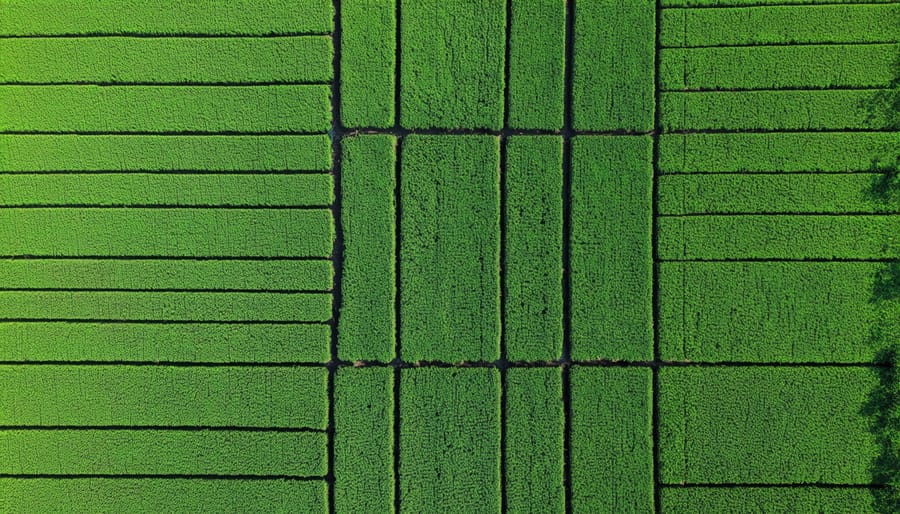
Subsurface Infiltration Systems
Subsurface infiltration systems are becoming increasingly popular among Alberta farmers as an efficient way to manage water resources beneath the soil surface. These underground networks typically consist of perforated pipes or chambers that distribute water throughout the root zone, providing optimal moisture levels for crop growth.
Rob Anderson, a farmer from Red Deer County, implemented a subsurface system three years ago and reports a 30% increase in water efficiency. “The system practically pays for itself through water savings and improved yield consistency,” he shares. The installation involves placing distribution pipes at depths between 40 to 60 centimetres, depending on soil type and crop requirements.
These systems work particularly well in our prairie soil conditions, where they help prevent surface runoff and reduce evaporation losses. They’re especially effective during our characteristically dry summers, ensuring crops receive consistent moisture even during extended dry periods.
When planning a subsurface system, consider starting with a soil assessment to determine optimal pipe depth and spacing. Many Alberta farmers have found success with spacing intervals of 3 to 4 metres between lines for most field crops. The initial investment might seem substantial, but local agricultural grants often help offset installation costs.
Remember to include shut-off valves and monitoring points in your design for easier maintenance. Regular inspection of these access points, especially before winter, helps prevent freeze damage and ensures long-term system reliability.
Natural Enhancement Strategies
Cover crops and organic matter play crucial roles in enhancing natural water infiltration on Alberta farms. By implementing strategic water-saving strategies, farmers can significantly improve their soil’s ability to absorb and retain moisture.
Winter cereals, legumes, and deep-rooted crops like alfalfa create extensive root networks that act as natural channels for water movement. These cover crops protect the soil surface from erosion while adding valuable organic matter when terminated. Many Alberta farmers have found success with fall rye and winter wheat, which establish quickly and provide excellent soil coverage during spring melt.
Maintaining organic matter levels through crop residue management and reduced tillage is equally important. Every 1% increase in organic matter can help soil hold an additional 25,000 litres of water per hectare. Local farmers report that leaving stubble standing through winter not only traps snow but also provides natural mulch that slows spring runoff.
Composting and incorporating green manures have proven effective in building soil structure. These practices create stable soil aggregates that improve pore space and water movement. For best results, rotate cover crops and vary organic matter inputs to build a resilient soil ecosystem that naturally enhances water infiltration year after year.
Real Results: Alberta Success Stories
Central Alberta Grain Farm Case Study
The Smith family farm, located 30 kilometers east of Red Deer, Alberta, transformed their 2,000-hectare grain operation through innovative water infiltration practices. In 2018, facing recurring spring flooding and summer drought issues, they implemented a comprehensive water infiltration system that has since become a model for central Alberta farmers.
The system combines strategically placed grassed waterways with contour farming and the installation of French drains across their most vulnerable fields. Key modifications included establishing 12 kilometers of grassed waterways following natural drainage patterns and installing subsurface drainage pipes at 15-meter intervals in low-lying areas.
After three years of implementation, the results have been remarkable. Spring seeding now starts 7-10 days earlier than before, as fields dry more uniformly. Crop yields have increased by 22% on average, with particularly significant improvements in traditionally wet areas. Soil organic matter has improved from 3.2% to 4.1%, indicating better soil health and water retention.
The Smiths report annual cost savings of approximately $45,000 through reduced equipment wear, more efficient field operations, and decreased input costs. Perhaps most importantly, they’ve eliminated crop losses from waterlogging, which previously affected up to 15% of their land annually.
Local farmers regularly visit the Smith farm to learn about their system, contributing to a growing community of producers adopting similar practices across central Alberta.
Southern Alberta Market Garden Experience
In southern Alberta, market gardeners have successfully adapted water infiltration systems to suit their smaller-scale operations. The Lethbridge Community Garden Project demonstrates how these systems can work effectively on plots as small as 0.4 hectares. Local farmer Sarah Thompson’s innovative approach combines traditional drip irrigation with strategically placed infiltration zones, allowing her to maximize water efficiency while maintaining soil health on her 2-hectare vegetable farm.
These smaller systems typically utilize simpler components than their large-scale counterparts. Many market gardeners in the region have found success with basic French drain setups, enhanced with locally sourced materials like river rock and recycled perforated pipes. The systems are often integrated with mulching practices and cover cropping to improve overall water retention.
The Medicine Hat Growers Cooperative reports that members using these modified infiltration systems have reduced their water usage by 30-40% compared to conventional irrigation methods. This improvement is particularly significant during the hot summer months when water conservation becomes crucial.
Cost-effective solutions have emerged from the market garden community, with many growers developing DIY approaches that maintain effectiveness while keeping installation expenses manageable. For instance, the Raymond Agricultural Society’s demonstration garden showcases a simple yet effective system built for under $500, proving that water infiltration solutions can be accessible to small-scale producers.
Implementation Guide: Getting Started

Assessment and Planning
Before implementing a water infiltration system, conducting a thorough assessment of your farm’s specific needs and conditions is essential. Start by evaluating your soil type, testing its current infiltration rate, and identifying areas prone to water pooling or erosion. Map out your land’s topography and note existing drainage patterns to understand water flow across your property.
Consider your farm’s production goals and how they align with various soil and water conservation practices. Document your current irrigation methods and assess their effectiveness. This information will help determine the most suitable infiltration system for your operation.
Create a detailed implementation plan that includes:
– Soil improvement strategies
– System design and layout
– Installation timeline
– Required equipment and materials
– Budget considerations
– Maintenance schedule
Consult with local agricultural extension services or conservation authorities who can provide region-specific guidance. They can help you understand local regulations and available support programs. Many Alberta farmers have found success by starting with a small-scale pilot project before expanding their system farm-wide, allowing for adjustments based on real-world performance.
Remember to factor in seasonal variations and extreme weather events common to your area when planning your system’s capacity and design specifications.
Cost Considerations and Resources
Implementing a water infiltration system requires careful financial planning, but several cost-sharing programs and resources are available to help Alberta farmers manage the investment. Initial costs typically range from $2,000 to $15,000 per hectare, depending on the system’s complexity and existing soil conditions.
The Canadian Agricultural Partnership (CAP) offers funding assistance of up to 70% for eligible water management projects, including infiltration systems. Local Agricultural Service Boards also provide technical support and may offer additional financial incentives for sustainable water management practices.
Equipment costs can be minimized through equipment-sharing programs available through various farming cooperatives across Alberta. Many farmers find success by starting with smaller pilot areas and gradually expanding their systems based on results and available resources.
Free consultations are available through Alberta Agriculture and Forestry’s water specialists, who can help assess your land’s specific needs and develop cost-effective solutions. The Environmental Farm Plan program provides additional resources and potential funding opportunities for farmers implementing water management practices.
Remember to factor in long-term benefits when considering costs – improved water infiltration typically leads to reduced irrigation needs and increased crop yields, offering substantial returns on investment within 3-5 growing seasons.
Water infiltration systems represent a crucial investment in the long-term sustainability of Canadian farms. By implementing these systems, Alberta farmers can significantly improve soil health, increase crop yields, and build resilience against both drought and excess moisture conditions. The evidence from local farms shows that proper water infiltration management leads to reduced erosion, better nutrient retention, and more consistent crop performance across varying weather patterns.
Remember that success with water infiltration systems comes from a combination of careful planning, regular maintenance, and adaptive management practices. Start small, monitor results, and gradually expand your system based on what works best for your specific soil conditions and farming operation. Consider connecting with local agricultural extension services and experienced farmers who have already implemented these systems successfully.
Take the first step today by assessing your current soil conditions and identifying areas where improved water infiltration could benefit your farm. The investment in time and resources now will pay dividends in the form of healthier soil, more sustainable operations, and improved farm productivity for years to come. Together, we can build a more resilient agricultural future for Alberta and beyond.

